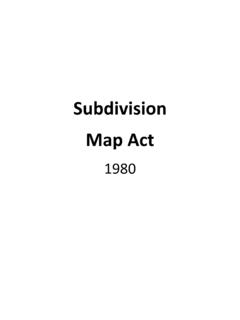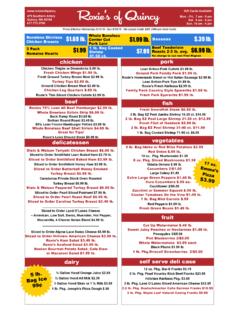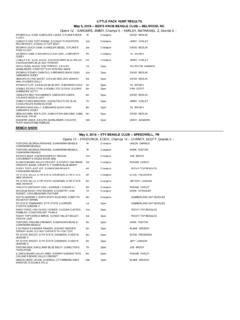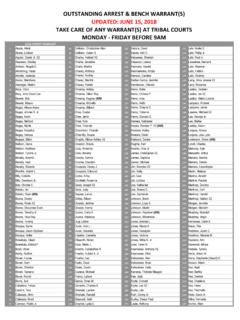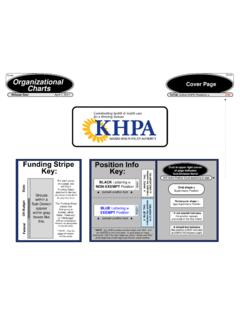Transcription of 05/27/76 Fred A. CHAPMAN, Jr. and v. Norman MOSER and …
1 05/27/76 Fred A. chapman , Jr. and v. Norman MOSER and wife , [1] UNITED STATES COURT OF APPEALS FOR THE FIFTH CIRCUIT [2] Fred A. chapman , Jr. and William C. chapman , [3] Plaintiffs-Appellees, v. [4] Norman MOSER and wife , Laura Allen MOSER , [5] Defendants-Appellants [6] No. 74-3635 [7] May 27, 1976 [8] As Amended. [9] Appeal from the United States District Court for the Eastern District of Texas. [10] APPELLATE PANEL: [11] Wisdom, Clark and Roney, Circuit Judges. [12] DECISION OF THE COURT DELIVERED BY THE HONORABLE JUDGE RONEY [13] This is a trespass to try title action brought to quiet title to five tracts of Texas ranch land totaling acres, including both deeded land and land accreted by the action of the Red River.
2 The property is located at the disputed common boundary between two adjoining ranches. At the outset of litigation both the plaintiffs and the defendants asserted record title, and limitation title whereby each party asserted peaceable adverse possession for the requisite number of years under various statutes of limitation. Vernon's Arts. 5507 ff. The action is cognizable under the federal courts' diversity jurisdiction, 28 1332, the plaintiffs residing in Oklahoma, the defendants in Texas. The case was tried under Texas law before a jury which answered all questions posed in a series of special interrogatories in favor of the plaintiffs.
3 The trial court denied defendants' motion for judgment n. o. v. but awarded one small parcel to the defendants and apportioned a large parcel of accreted land between the parties.*fn1 The remaining three tracts were awarded to the plaintiffs. [14] Although complicated by a network of legal theories and by alleged errors in the application of relevant law, this appeal is primarily an attack on the jury's findings of fact concerning the plaintiff Chapmans' adverse possession of the disputed tracts of river frontage. We find that the trial court properly applied the Texas law of adverse possession and apportionment, and we conclude that the jury's factual determination that the plaintiffs established their adverse possession to the exclusion of the defendants was supported by substantial evidence under the appropriate standard of review.
4 We therefore affirm the judgment of the district court. [15] In 1917 P. A. and Roxie chapman , the grandparents of the plaintiffs, purchased property which now comprises both the present chapman ranch and a portion of the MOSER ranch. The land in question is bounded on the north by the Red River, which had changed its course so extensively that P. A. and Roxie chapman did not have definitive title to the river frontage until 1923 when the Supreme Court settled a boundary dispute between Texas and Oklahoma. State of Oklahoma v. State of Texas, 260 606, 43 S. Ct. 221, 67 L. Ed. 428 (1923). See also Oklahoma v.
5 Texas, 269 314, 46 S. Ct. 164, 70 L. Ed. 285 (1926). Pursuant to this litigation the United States conducted a survey in 1926, which first identified the Harris Bend Cutoff, the northeasternmost portion of the original chapman ranch, a body of land lying to the east of a dry, former river run. [16] In 1936 Mrs. Roxie chapman sold the cutoff to a party named Smalley, and the area then became known as Smalley Island. By 1960 Smalley Island was in the possession of John Farris Johnston, who sold it to the Mosers. The four tracts disputed in this appeal are partially accreted, partially deeded lands located at the tip and to the northwest of Smalley Island.
6 [17] In about 1954 the Chapmans decided to discontinue permanent grazing of the lands involved in this litigation, because the tracts are adjacent to the Red River and had become marshy. They constructed an interior fence, which the Mosers took to be a division fence. The Mosers and Chapmans both, apparently, made sporadic use of the unenclosed marshy lands, hunting the property and occasionally removing timber. In the mid to late 1960's, perhaps 1967, defendants began to clear the disputed lands. In 1970 they repaired and added to the Chapmans' interior fence. Bad feelings ensued, leading to the institution of this lawsuit in 1972.
7 [18] In its answers to nine interrogatories, the jury's findings provide the factual basis for establishing title in the plaintiffs on a number of theories recognized under Texas law. The Chapmans' title could be recognized in accordance with the jury's fact finding, by proof of a superior title out of a common source, or by limitation titles. Gray v. Joyce, 485 311 (Tex. Civ. App. 1972); Perkins v. Smith, 476 902 ( 1972); see Land v. Turner, 377 181 ( ); Hejl v. Wirth, 161 Tex. 609, 343 226 (1961). [19] In examining the jury's finding on the evidence we will discuss the case by reference to the 25 year limitation title, Vernon's Art.
8 5519, the factual proof of which exacted the most stringent burden of the plaintiffs. [20] At trial the defendants objected to the submission of the plaintiffs' claim of limitation title under the 10 and 25 year statutes of limitations, asserting that the evidence did not warrant submission. Similarly, after the verdict was returned they moved for judgment n. o. v., arguing that the overwhelming weight of the evidence established their title by limitation under the 10 year statute, even though the jury had explicitly held to the contrary on an interrogatory pertaining to this affirmative defense.
9 [21] Since the Mosers moved for judgment n. o. v., we must review the evidence as a whole, in light of our standard of review enunciated in Boeing Co. v. Shipman, 411 365, 374-375 (5th Cir. 1969) (en banc): [22] On motions for directed verdict and for judgment notwithstanding the verdict the Court should consider all of the evidence - not just that evidence which supports the non-mover's case - but in the light and with all reasonable inferences most favorable to the party opposed to the motion.. A mere scintilla of evidence is insufficient to present a question for the jury. The motions for directed verdict and judgment n.
10 O. v. should not be decided by which side has the better of the case, nor should they be granted only when there is a complete absence of probative facts to support a jury verdict. There must be a conflict in substantial evidence to create a jury question. [23] See also United States v. Denby, 522 1358 (5th Cir. 1975). Our review of the record reveals that the evidence warranted submission of the relevant fact issues to the jury. [24] Under Texas law, the plaintiff in a trespass to try title suit has the burden of proving good title in himself to the disputed land. He cannot prevail merely on the weakness of the defendant's title.
